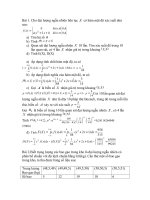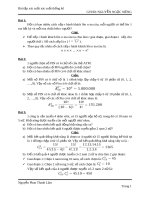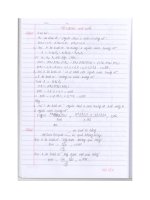Bài tập xác suất thống kê 1
Bạn đang xem bản rút gọn của tài liệu. Xem và tải ngay bản đầy đủ của tài liệu tại đây (134.13 KB, 4 trang )
introduction to statistics Fall 2010
Exercise 9
P (Z < x) = P (Z > −x) = 1 − P (Z > x)
(1)
P (Z < −x) = P (Z > x) = 1 − P (Z < x)
(2)
1. Use a table of z-scores to determine the following proportions:
(a) below z = 1.5
P (Z < 1.5) = 0.9332
(b) below z = -0.085
0.5319 + 0.5359
Using Eq(2): P (Z < −0.085) = P (Z > 0.085) = 1 −
=
2
0.4661
(c) above z = 2.8
Using Eq(2): P (Z > 2.8) = 1 − P (Z < 2.8) = 1 − 0.9974 = 0.0026
(d) above z = -1.09
Using Eq(1): P (Z > −1.09) = P (Z < 1.09) = 0.8621
(e) between z = 1.5 and z = 2.8
P (Z < 2.8) − P (Z < 1.5) = 0.9974 − 0.9332 = 0.0642
(f ) between z = -2.455 and z = 1.765.
P (Z < 1.765) − P (Z < −2.455) = 0.9612 − (1 − 0.993) = 0.9542
2. Use a table of z-scores to determine the following z-values:
(a) the value below which 0.25 of the distribution falls
Using Eq(1): P (Z < x) = 0.25 = 1 − P (Z > x)
P (Z > x) = 0.75
P (Z < −x) = 0.75
Looking up z-score gives us: -x = 0.67
x = -0.67
(b) the value below which 0.85 of the distribution falls
P (Z < x) = 0.85
x = 1.04
(c) the value above which 0.725 of the distribution falls
P (Z > x) = 0.725
P (Z < −x) = 0.725
Looking up z-score gives us: -x = 0.6
x = -0.6
(d) the value above which 0.05 of the distribution falls
P (Z > x) = 0.05
1 − P (Z < x) = 0.05
P (Z < x) = 0.95
x=1.65
3. Let X be a discrete random variable, and let a be such that P (X = a) > 0. Show
that P (X ≤ a) = P (X < a) + P (X = a). How the equality changes if we let X be
a continuous random variable.
1
Discrete random variables can be written as sequence of isolated values.
Let a be in a sample space of positive integer values. Then we can write:
P (X ≤ a) = P (X = 0) + P (X = 1) + .. + P (X = a − 1) +P (X = a)
P(X < a)
P (X ≤ a) = P (X < a) + P (X = a)
When X is continuous, P depends on an area under the distribution curve
and P(X = a) = 0 because for area to be measures, we need an interval!
The equation thus reduces to:
P (x <= a) = P (x < a)
4. A researcher collects opinion poll data in a busy shopping centre on support for
public flogging for misdemeanours, and vegetarianism. The data is shown as a
cross-tabulation of frequencies, below.
Supports Opposes
V egetarian
35
15
M eat eater
15
35
Assuming that this is a representative sample of the Finnish population.
(a) What is the probability that a Finn vegetarian supports flogging?
P(supports|vegetarian) = 35/50 = 70%
(b) What is the likelihood that a randomly selected person will be a meat eater,
and support flogging?
P (meat eater ∩ supports) = 15/100 = 15%
(c) Can you think of any way in which we could use probability calculations to
decide whether the variables vegetarianism support and flogging support are
independent?
Show P (vegetarianism∩f logging) = P (vegetarianism)P (f logging)
P (vegetarian support) = 50/100
P (f logging support) = 50/100)
P (vegetarianism)P (f logging) = 0.5 × 0.5
P (vegetarianism support ∩ f logging support) = 0.35 = 0.25
Vegetarianism support and flogging support are DEPENDENT.
5. In a study to examine helping behaviour we ask a confederate (a little old lady) to
pretend to collapse in the main road. We count the number of people that walk
by before assistance is rendered. We repeat the procedure 2000 times over a period
of one year. The data are normally distributed with a mean of 20 and a standard
deviation of 5.
(a) If we assume that this is the data for the population of cases of helping behaviour, what is the probability that at least 35 people will walk past a little
old lady who collapses in the main road?
2
Let X = number of people who walk by
35 − 20
)
P (X > 35) = P (Z >
5
P (Z > 3) = 1 − P (Z < 3) = 1 − 0.9987 = 0.0013
(b) What is the 25th percentile of helping behaviour?
p − 20
p − 20
Want P (Z <
) = 0.25 = 1 − P (Z >
)
5
5
p − 20
−(p − 20)
P (Z >
) = 1 − 0.25 = 0.75 = P (Z <
), by Eq(2).
5
5
Looking up z-score:
−(p − 20)
≈ 0.674
5
Solve for p ≈ 16.63
6. A Regional Football Association (RFA), has been advised by a team of social psychology consultants that crowd disturbances at football matches are much more
likely to occur on very hot and very cold days. Apparently, these extreme weather
conditions frustrate people, and this frustration easily boils over into crowd disturbances. RFA decide that they will call off any scheduled football match if the
temperature is more extreme than it is 98.5% of the time. If the daily temperature
is normally distributed with a mean of 22 and a standard deviation of 9, at what
temperatures will RFA call off soccer matches?
Want the extremely hot (t) and extremely cold (-t) temperatures.
That is,
t − 22
P (Z > a) = P (Z >
) = 1 − 0.985 = 0.015 by Eq(2), and
9
−(t − 22)
P (Z < −a) = P (Z <
) = 0.015, also by Eq(2).
9
Looking up z-scores gives us:
t − 22
= 2.17 and
9
−(t − 22)
= 2.17
9
Solving for t gives temperatures of 41.53 and 2.47, respectively.
3
7. A shop receives a batch of 1000 cheap lamps. The odds that a lamp is defective are
0.1%. Let X be the number of defective lamps in the batch.
(a) What kind of distribution does X have? What is/are the value(s) of parameter(s) of this distribution?
We are given 2 parameters: N = 1000, p = 0.001. Additionally, E(X)
= Np = 100 and we are dealing with discrete distributions. Therefore,
Binomial(N,p).
(b) What is the probability that the batch contains no defective lamps? One
defective lamp? More than two defective ones?
1000!
(0.001)0 (0.999)1000 = 0.9991000 = 0.367695425
P (X = 0) =
0!(1000 − 0)!
P (X = 1) = 0.368063488
P (X > 2) = 0.080209343
8. The long-term average for the number of rainy days in Cape Town during the
month of April is known to be 9.3, with a standard deviation of 3.6. What is the
probability that a visitor to Cape Town in the month of April will experience more
than 15 days of rain?
Let X = rainy day
15 − 9.3
= P (Z > 1.58)
3.6
P (Z > 1.58) = 1 − P (Z < 1.58) = 1 − 0.9429 = 0.0571
P (X > 15) = P (Z >
4









